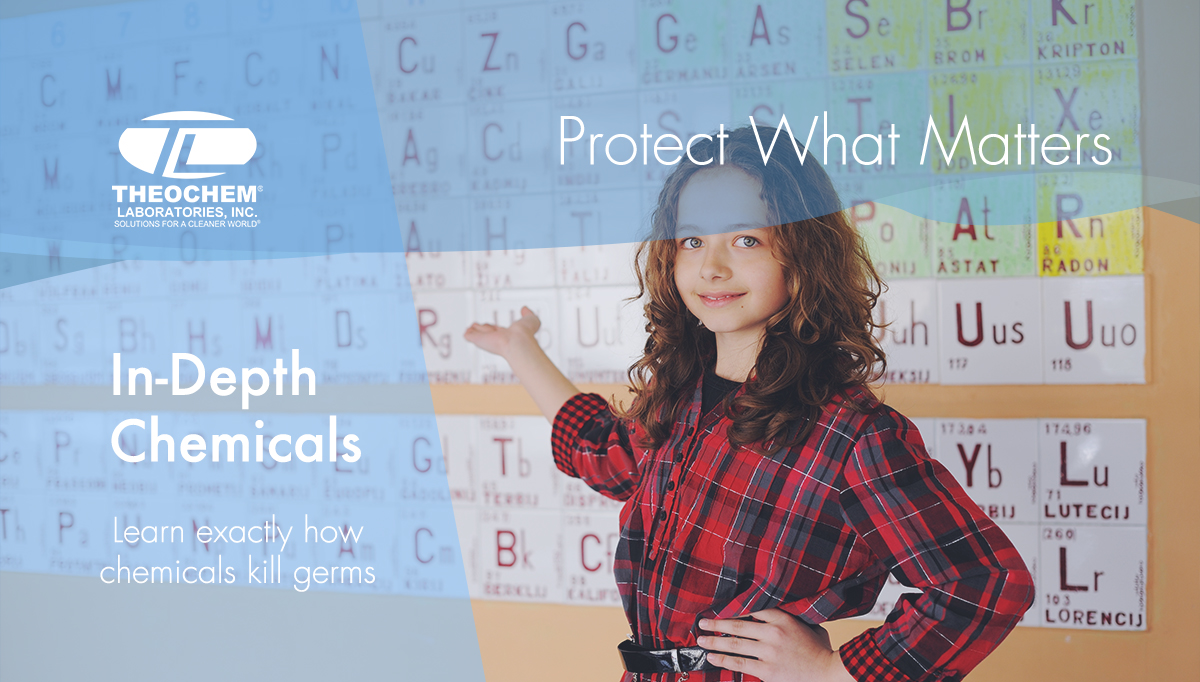What are some solutions that professional chemists have found that help us fight germs and bacteria? Is it as simple as one chemical killing another? Well, no. Not only is there a technical science behind chemical cleaning, when choosing a cleaner, but you also need to first know what microorganisms a specific chemical reduces or eliminates.
Different Types of Chemicals for Different Surfaces
Disinfecting chemicals can be used to effectively reduce & sterilize microbial populations. Disinfectants are classified by the specific action they perform on different types of microorganisms.
- Bactericides – Kills vegetative microorganisms
- Sporocides – Kills spores
- Viricides – Kill Viruses
- Fungicides – Fungi
- Antiseptic – These chemicals can safely disinfect skin and mucus membrane surfaces.
- Bacteriostatic – Prevents the reproduction of bacterias without killing them.
Chemical Interactions That Kill Germs
Chemical agents can affect cells in a variety of ways:
*Protein coagulation. Most proteins in a cell are enzymatic and are finely dispersed throughout the cell. Disinfecting chemicals that cause those proteins to precipitate & coagulate make the cell non-functional, killing the bacteria.
*Disrupting the cell membrane. The cell membrane acts as a barrier for the cell, letting some solutions be absorbed and rejecting others. Some chemical solutions that concentrate at the cell wall can alter that membrane, which prevents it from functioning properly.
*Removal of free sulphydryl groups. Many of the enzyme proteins in a cell contain cysteine (an amino acid) and have side chains terminating in sulphydryl groups. These enzymes cannot function unless the sulphydryl groups remain free and reduced. If the sulphydryl groups are tied down — for example, by an oxidizing agent such as chlorine – widespread damage to the cell occurs, and the cell dies.
*Chemical antagonists. Enzymes perform their catalytic function through their affinity for specific chemical compounds normally found within cells, referred to as their “natural substrates.” If a disinfecting compound structurally resembles a substrate in its essential aspects, the enzyme will have an affinity for that compound. If this affinity is strong enough, the compound will take the place of the normal substrate of the enzyme and prevent the proper reaction from occurring — thereby inhibiting the reproduction of the cell.
Ethyl alcohol (ethanol) and isopropyl alcohol are frequently used for chemical disinfection. You can use them as skin antiseptics. They act by “denaturing” or altering the molecular structure of bacterial proteins, destroying the cell. Alcohols kill vegetative forms of bacteria but have no action on spores or viruses.
Aldehydes — like formaldehyde– are active against amino organic compounds in protein molecules and are bactericidal and sporicidal, also exerting a lethal effect on influenza and poliomyelitis viruses.
Chlorine has been used for many years as a disinfectant and has generally been associated with the treatment of swimming pools. Chlorine gas reacts with water to form hypochlorous acid (HOCl). Chlorine and hypochlorites are bactericidal and act by oxidizing the cell membrane.
Iodine is most often used as a skin disinfectant. It combines with cell protein and is an active germicidal agent with moderate activity against spores. It is effective against the tubercle bacillus and many other viruses.
Phenol (an acidic compound) was the forerunner of a wide range of phenolic compounds developed as disinfectants. The activity of phenolic compounds against microorganisms depends upon the type of compound used. Organic matter tends to absorb phenol and lowers the concentration available to kill microorganisms.
Phenol, a corrosive substance, is toxic to living tissues and act on the bacterial cell by denaturing and coagulating the protein within the cell. In low concentrations, phenol disrupts the cell wall, allowing leakage of cellular constituents.


